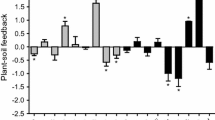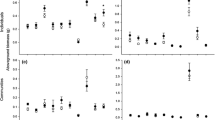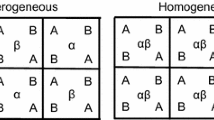Abstract
The presence of small-scale patches of soil resources has been predicted to increase competition, because multiple species will proliferate roots in the same small area, and therefore decrease plant diversity. I tested whether such patches reduced species evenness in a community of four old-field species, both with and without interspecific interactions. In species mixtures, patches reduced evenness, while in “communities” constructed via combined monocultures, in which species did not compete, patches increased evenness. Therefore, the reduction in evenness in response to patches was due to changes in competition. Community-level changes may be attributable to plant foraging traits—in species with low foraging precision, competition reduced abundance much more in patchy soils than in even soils, while in species with high root foraging precision, the effect of competition was similar in patchy and even soils.




Similar content being viewed by others
References
Bliss KM, Jones RH, Mitchell RJ, Mou PP (2002) Are competitive interactions influenced by spatial nutrient heterogeneity and root foraging behavior? New Phytol 154:409–417
Cahill JF, Casper BB (1999) Growth consequences of soil nutrient heterogeneity for two old-field herbs, Ambrosia artemisiifolia and Phytolacca americana, grown individually and in combination. Ann Bot 83:471–478
Cain ML, Subler S, Evans JP, Fortin MJ (1999) Sampling spatial and temporal variation in soil nitrogen availability. Oecologia 118:397–404
Campbell BD, Grime JP, Mackey JML (1991) A trade-off between scale and precision in resource foraging. Oecologia 87:532–538
Day KJ, John EA, Hutchings MJ (2003) The effects of spatially heterogeneous nutrient supply on yield, intensity of competition and root placement patterns in Briza media and Festuca ovina. Funct Ecol 17:454–463
Einsmann JC, Jones RH, Pu M, Mitchell RJ (1999) Nutrient foraging traits in 10 co-occurring plant species of contrasting life forms. J Ecol 87:609–619
Farley RA, Fitter AH (1999a) The responses of seven co-occurring woodland herbaceous perennials to localized nutrient-rich patches. J Ecol 87:849–859
Farley RA, Fitter AH (1999b) Temporal and spatial variation in soil resources in a deciduous woodland. J Ecol 87:688–696
Fransen B, de Kroon H, Berendse F (2001) Soil nutrient heterogeneity alters competition between two perennial grass species. Ecology 82:2534–2546
Goldberg DE (1994) Influence of competition at the community level: an experimental version of the null models approach. Ecology 75:1503–1506
Hodge A (2004) The plastic plant: root responses to heterogeneous supplies of nutrients. New Phytol 162:9–24
Hutchings MJ, John EA, Wijesinghe DK (2003) Toward understanding the consequences of soil heterogeneity for plant populations and communities. Ecology 84:2322–2334
Jackson RB, Caldwell MM (1989) The timing and degree of root proliferation in fertile-soil microsites for three cold-desert perennials. Oecologia 81:149–153
Jackson RB, Caldwell MM (1993a) Geostatistical patterns of soil heterogeneity around individual perennial plants. J Ecol 81:683–692
Jackson RB, Caldwell MM (1993b) The scale of nutrient heterogeneity around individual plants and its quantification with geostatistics. Ecology 74:612–614
Johnson HA, Biondini ME (2001) Root morphological plasticity and nitrogen uptake of 59 plant species from the Great Plains grasslands, USA. Basic Appl Ecol 2:127–143
Kembel SW, Cahill JF Jr (2005) Plant phenotypic plasticity belowground: a phylogenetic perspective on root foraging trade-offs. Am Nat 166:216–230
Kembel SW, de Kroon H, Cahill JF Jr, Mommer L (2008) Improving the scale and precision of hypotheses to explain root foraging ability. Ann Bot 101:1295–1301
Lechowicz MJ, Bell G (1991) The ecology and genetics of fitness in forest plants II. Microspatial heterogeneity of the edaphic environment. J Ecol 79:687–696
Maestre FT, Bradford MA, Reynolds JF (2006) Soil heterogeneity and community composition jointly influence grassland biomass. J Veg Sci 17:261–270
Magurran AE (1988) Ecological diversity and its measurement. Princeton University Press, Princeton
Rajaniemi TK (2007) Root foraging traits and competitive ability in heterogeneous soils. Oecologia 153:142–152
Rajaniemi TK, Reynolds HL (2004) Root foraging for patchy resources in eight herbaceous species. Oecologia 141:519–525
Robinson D (1994) The responses of plants to non-uniform supplies of nutrients. New Phytol 127:635–674
Ryel RJ, Caldwell MM, Manwaring JH (1996) Temporal dynamics of soil spatial heterogeneity in sagebrush-wheatgrass steppe during a growing season. Plant Soil 184:299–309
Smith B, Wilson JB (1996) A consumer’s guide to evenness indices. Oikos 76:70–82
Tilman D (1982) Resource competition and community structure. Princeton University Press, Princeton
Tilman D, Pacala SW (1993) The maintenance of species richness in plant communities. In: Ricklefs RE, Schluter D (eds) Species diversity in ecological communities: historical and geographic perspectives. University of Chicago Press, Chicago, pp 13–25
Wijesinghe DK, Whigham DF (2001) Nutrient foraging in woodland herbs: a comparison of three species of Uvularia (Liliaceae) with contrasting belowground morphologies. Am J Bot 88:1071–1079
Wijesinghe DK, John EA, Hutchings MJ (2005) Does pattern of soil resource heterogeneity determine plant community structure? An experimental investigation. J Ecol 93:99–112
Acknowledgments
Thanks to Rebecca Guaraldi for help with harvesting. Heather Reynolds and two anonymous reviewers provided helpful comments on the manuscript. These experiments comply with current laws of the USA.
Author information
Authors and Affiliations
Corresponding author
Additional information
Communicated by Scott Collins.
Rights and permissions
About this article
Cite this article
Rajaniemi, T.K. Competition for patchy soil resources reduces community evenness. Oecologia 165, 169–174 (2011). https://doi.org/10.1007/s00442-010-1710-5
Received:
Accepted:
Published:
Issue Date:
DOI: https://doi.org/10.1007/s00442-010-1710-5




